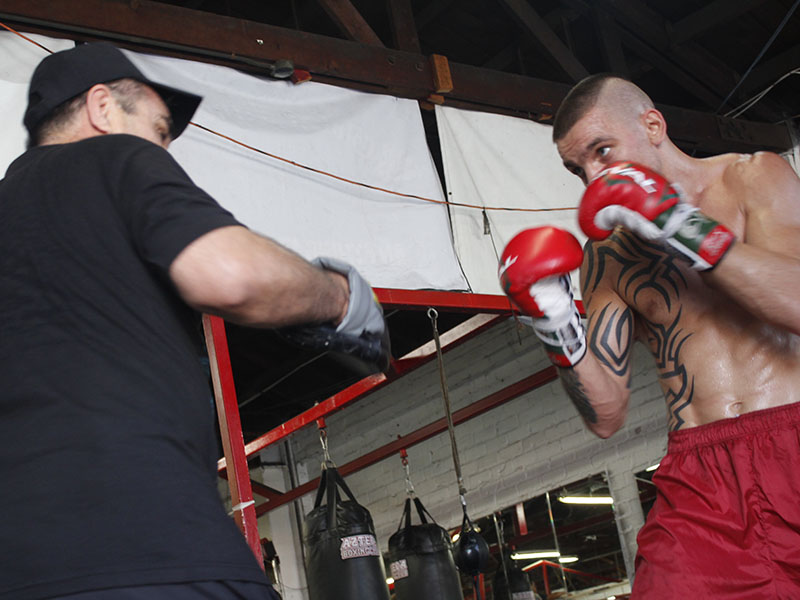
Redkach preps for an upcoming bout.
One of the hardest things for a boxer to do is to hang up his gloves. But if you can no longer be a champion, why not make one?

Redkach preps for an upcoming bout.

Morales is a staple of Azteca Boxing Club, and can be found there frequently.
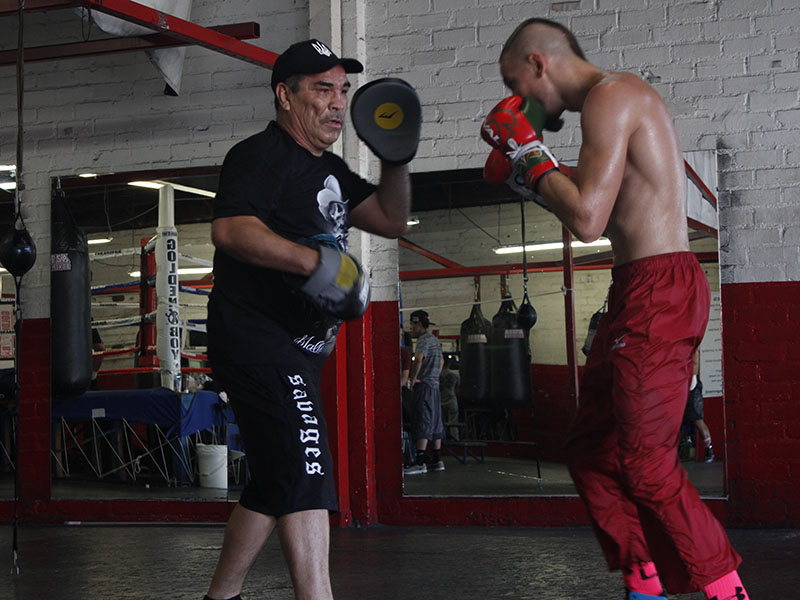
Originally from the Ukraine, Redkach and Morales speak to each other in Spanish..
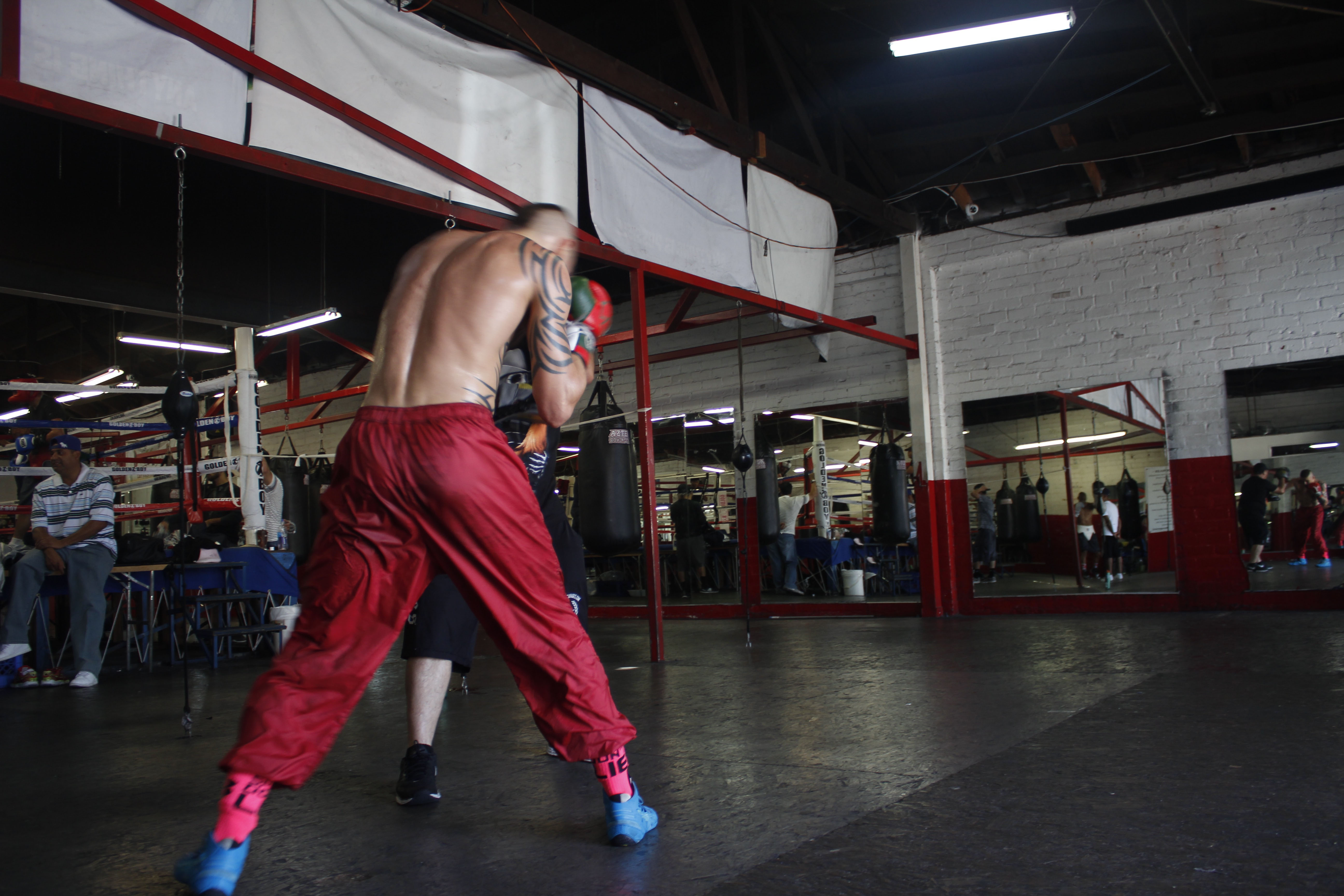
While trainers expect their fighters to be conditioned all year round, the real training for a fight usually begins about 4-6 weeks prior to the bout.
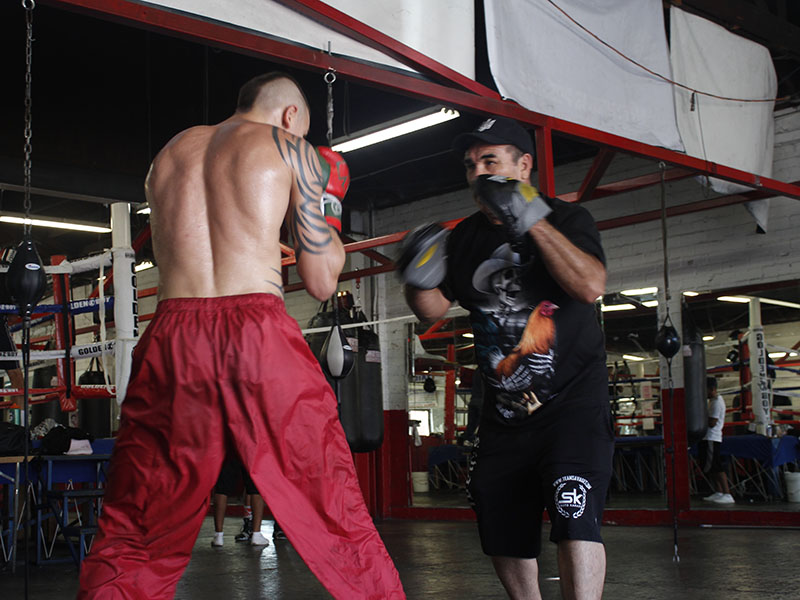
In 2012 and 2013, Redkach was named one of ESPN's "Top 20 Prospects to Watch."
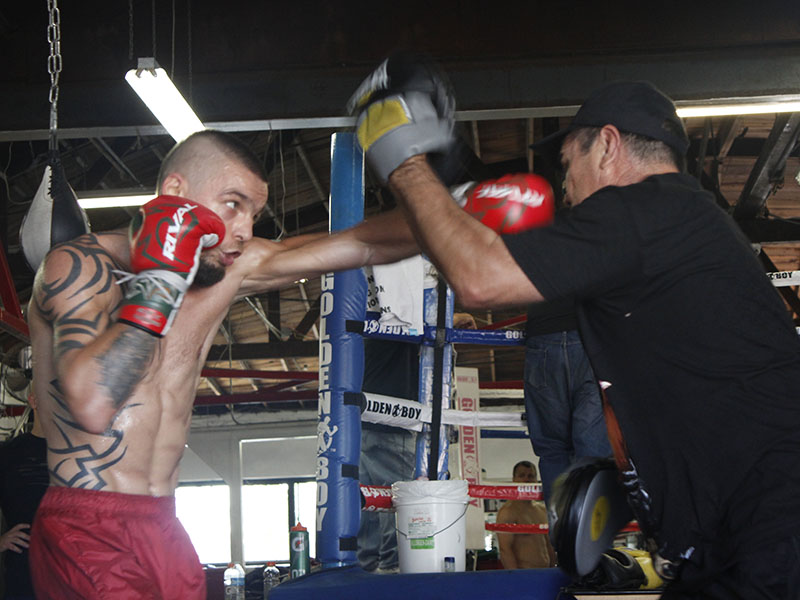
Redkach is one of a growing number of Eastern European boxers who are making L.A. their training base.
For many boxing fans, the beauty and brutality of boxing lies in its simplicity.
It’s one man against one man. Each round is three minutes of strategy, attack and concentration. There are no time-outs, no tools or ornaments except the boxer’s body and his mind.
And when it comes to preparing a fighter for the sweet science of bruising, there may be no one more important to a young fighter than his trainer. Charged with steering their fighter to victory, a good trainer can do everything from strategizing and building his fighter’s strength and stamina to teaching technique and curbing bad habits.
But perhaps most important is building a fighter’s mind.
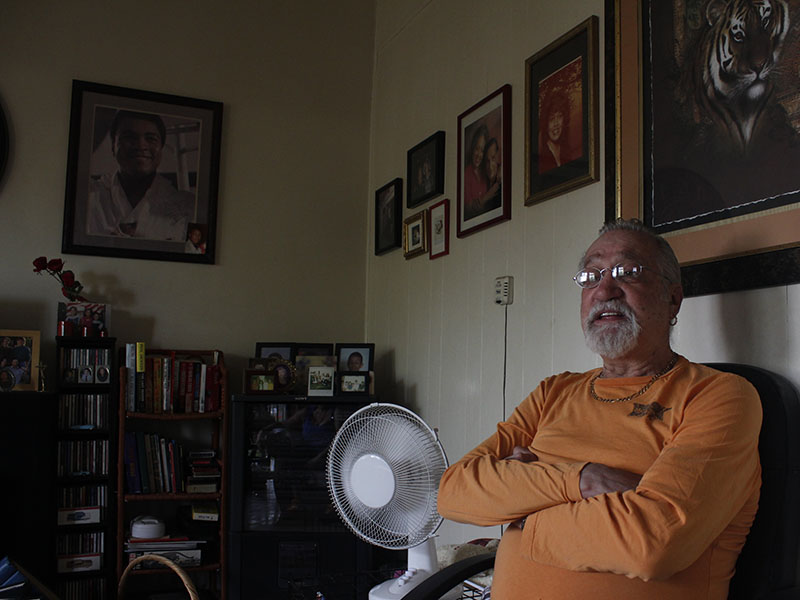 Al "Stankie" Stankiewicz at home in Carson City, California (Anne Branigin / Annenberg Media)
Al "Stankie" Stankiewicz at home in Carson City, California (Anne Branigin / Annenberg Media)
When it comes to trainers, in Los Angeles, Al, “Stankie” Stankiewicz is considered by many to be its godfather.
Stankiewicz has “one Mexican hip” — given to him by a Mexican client whom he taught how to box — and “one American hip.”
“And they’re fighting each other,” he laughs, leaning against a cane.
Much ink has been spilt in L.A. chronicling the rise and many falls of the 73 year old Stankiewicz. A former LAPD cop, Stankiwicz says he has “been to the mountaintop” in the sport — training Olympic gold medalists Paul Gonzales and Oscar De La Hoya, and former super featherweight champion Erik “El Terrible” Morales. While his own boxing career was short-lived, Stankiewicz’s love for the sport (he repeatedly uses the word “mesmerizing” to describe his first encounter with it) inspired him to train the young boys of the barrios in which he policed.
His explanation for his success is simple: he makes champions because he knows how to.
“If you can walk and talk and chew gum, I’ll take you to the top of your mountain,” says Stankiewicz. “That’s the confidence I have.”
But first, his fighters have to demonstrate to him the right qualities.
“It doesn’t matter who you are,” Stankiewicz says. “You give me five D’s and two A’s on your report card and I'll make you the champion.”
He lists the D’s: desire, determination, dedication, drive, and discipline — this last word he growls and repeats. Discipline, discipline, discipline. He lists the two A’s. Ability first, and then “the most important” — attitude. A fighter demonstrates these qualities to him simply by showing up every day to train, a task that may sound simple enough, but given the toughness of the sport, only a few will accomplish.
“The cream comes to the top, no matter who you are,” says Stankiewicz. “I don't care what kind of body you have, it's all your heart, your desire, your determination, your dedication, your drive and your discipline. They weed themselves out.”
To hear Stankiewicz tell it, the champions are simply the ones who stay.
 A fighter gets ready to begin sparring. (Anne Branigin/Annenberg Media)
A fighter gets ready to begin sparring. (Anne Branigin/Annenberg Media)
One fighter who embodied all these qualities for Stankiewicz is Paul Gonzales, the light flyweight from East L.A. who became the first Chicano to ever be draped with Olympic gold.
“I don’t know what surrender means,” says Gonzales, who now works for Parks and Recreation for the City of Los Angeles. He’s based out of Eddie Heredia gym, where he trains 8 to 19 year old kids. To Gonzales, fighting is “90 percent mental, and 10 percent ability.”
“You might have a lot of ability. You can move around, you can do your thing, you’re fast. That’s great. But it’s all mental,” says Gonzales. “Because a guy can be in there hitting you, boom boom boom, and he can be laughing at you. That messes with your psyche.”
And while Stankiewicz certainly prepared him physically — having him spar with partners up to twenty pounds heavier than him, having him train in the mountains to build his stamina and endurance — Gonzales remembers just as vividly how Stankiewicz would prepare him mentally.
Before each fight, Stankiewicz would have him pray, then repeat some affirmations.
“I'm strong, healthy, free from sickness and injury and fatigue. When their punches hit me, I don't feel them,” Gonzales rattles the affirmations off, short and quick as jabs. “When I hit them, I hurt them. I'm going to punch through them. I'm going to hit through them. I'm going to win.”
And after that: visualizing the fight. Visualizing the strategy, the way he would move across the canvas. Visualizing the victory. Over and over until he did it in his sleep.
“When I step in the ring and my feet hit the apron, I'm blanked,” says Gonzales. “Meaning, I’m in the zone. I'm in automatic mode.”
It was so automatic that he once boxed through a concussion. When facing an opponent in the first round, the other fighter’s uppercut connected with Gonzales’s chin.
“I was OUT,” Gonzales recalls. “First round, I went down. I got up, I had a concussion. I don't remember nothing, okay? All I remember was what I watched on the tape of the fight. I don't remember how I got up.”
What was really eerie was just how good he was. Gonzales ended up winning the fight.
"I was fighting off pure instinct. And you know what? My instincts beat the crap out of that dude.”
And in his corner was Stankiewicz.
During interviews leading up to the Olympics, Gonzales liked to tell the media, “These guys are fighting three people in the ring. Not just one. They're not just fighting me. They're fighting me, my trainer, and they're fighting God.”
“That’s going to be a tough fight.”
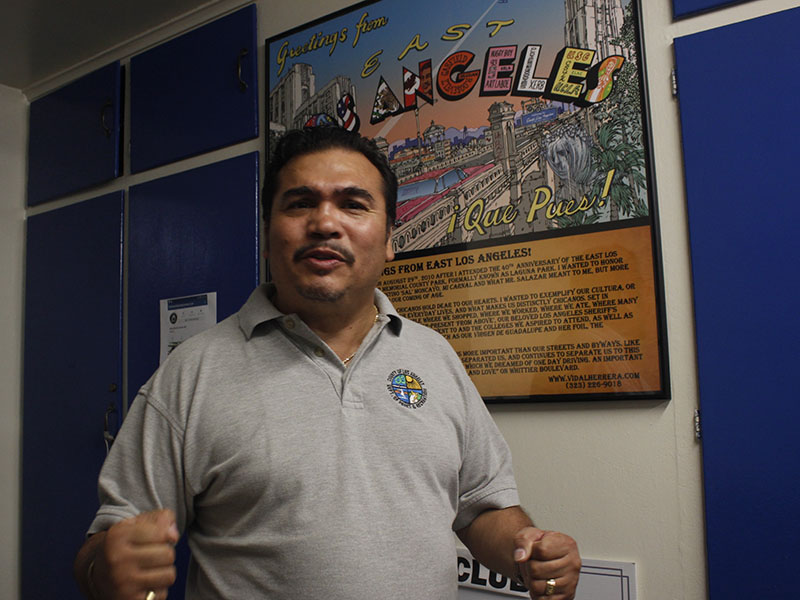 Gonzales in his office at the Eddie Heredia Boxing Club. (Anne Branigin/Annenberg Media)
Gonzales in his office at the Eddie Heredia Boxing Club. (Anne Branigin/Annenberg Media)
Gonzales, like several of Stankiewicz’s former fighters, still refers to him as "pops." And truly, one of the things that makes the trainer-fighter relationship unique in sports is how it can follow an athlete from childhood all the way to the upper echelons of the profession.
Rafe Bartholomew, who covers boxing for ESPN’s Grantland, notes that in football and basketball, an athlete’s childhood coach can’t follow him through high school, then college, then the professional leagues. However, in boxing, a trainer can raise his son in the sport through multiple levels. Because of that, “there’s more baggage in that relationship,” says Bartholomew.
“So much is passed on [in boxing] through shared knowledge. Boxers learn a style passed down from someone else,” says Bartholomew, adding that trainers not only influence their fighters, but younger trainers.
And because boxing attracts so many kids from low-income families and single-parent homes, even if the trainer isn’t a fighter’s biological father, he can quickly take on the role of a father figure, as Stankiewicz did with many of the boys he trained.
But as with many trainers, it means Stankie eventually had to let these boys, “his sons,” go — to women, to other trainers, to other endeavors outside the ring. While many of the old heads in the industry lament the disloyalty of today’s fighters, Stankiewicz doesn’t seem bothered by it.
“That’s life,” he shrugs. “The beat goes on. And the things that I learned from other guys I taught, other trainers … Me, I’m going to pass it on to [new trainers] so they can keep on going.” Once focused on making champions, Stankiewicz wants to develop trainers to raise up the new generation of fighters. And he’s looking at his sons to take on this work.
Stankiewicz’s focus right now is Adrian “Turtle” Carreon, a 43 year old former professional boxer and journeyman who has returned to Los Angeles to reinvent himself as a trainer. Carrion hopes to live the life of a champion again — by helping to create the next one.
“Once you become a fighter, the love of boxing will never die. It stays in your heart, and you live through these fighters, through these young fighters,” says Carreon. “You’re in there fighting. Your heart’s in there, part of you is in there. Until the day God takes you.”